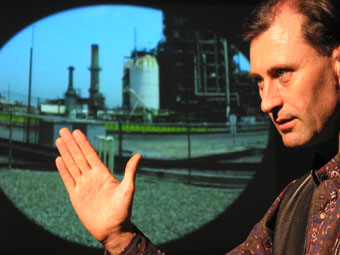Intelligent room with a view
Jeff Khan

Simon Penny with his work Fugitive II, 2004
Simon Penny’s major new work Fugitive II engages participants through an elaborate interactive system. A circular room features a 360 degree screen. As you enter, a number of sensors read and respond to your movements and gestures, triggering images on screen. This creates an uncanny sense of being ‘read’ by the room.
At any one time, only a small section of the 360 degree screen is in use. The rules of the interaction are disappointingly straightforward: move closer to the screen and the footage zooms in, walk around the room and the image follows you, get too close and it disappears, only to reappear behind you. Thus, while you and your movements are inextricably linked to the location and contents of the picture, the installation also works to keep participant and image at a distance, rendering the work’s interface something of an impenetrable surface. Windows seen in the film are zoomed in on as you approach them, but remain opaque and vanish if you get too close. A title screen announcing the name of the work appears seemingly at random, amplifying the disjointed feel of the interaction. The footage itself is of various suburban, industrial and recreational landscapes, devoid of human presence or signs of life. This emptiness deepens the sense of dislocation established by the image’s elusive movements.
The focus on the disembodying, elusive aspects of technology seems a curious choice considering the mode of close interactivity Simon Penny has developed for the installation. The simultaneous complicity and distance between participant and screen provides some interesting food for thought vis-a-vis technology’s “user-friendly” aspirations and the associated connotations of complicity and mutual understanding between human and machine. The experience of the work, however, is ultimately unsatisfying, a feeling enhanced by the jerky pans and zooms triggered by the more fluid movements of the participating body. The focus on the technology itself, both as a material and conceptual focal point of the work, ultimately makes for a limited and rather dry participatory experience.
Perhaps this dissatisfaction is heightened by the presence of Char Davies’ monumental Osmose and Ephèmére downstairs in the screen gallery as part of Transfigure (RT58; RT59). Despite the somewhat cumbersome equipment involved in their interactive systems, Davies’ works transcend their technology while using it to create a powerful connection between the participant’s physical presence, the moving imagery (also generated in response to the viewer’s movements) and a transformed sense of space. This anchor in lived, embodied experience, existing outside the mechanical framework of the work itself, provides a sense of engagement and discovery lacking in Fugitive II.
Limitations aside, Fugitive II is an interesting component in what has been a diverse program of work at the Australian Centre for the Moving Image exploring the multifarious applications and possibilities of interactive technology. It is especially encouraging, in the face of recent criticism and close scrutiny of ACMI as an institution, that the organisation continues to deliver a balanced and diverse program which intrigues, inspires and creates new possibilities for the viewing experience.
Fugitive II, Simon Penny, ACMI, Melbourne, Jan 8-March 14
RealTime issue #60 April-May 2004 pg. 26






